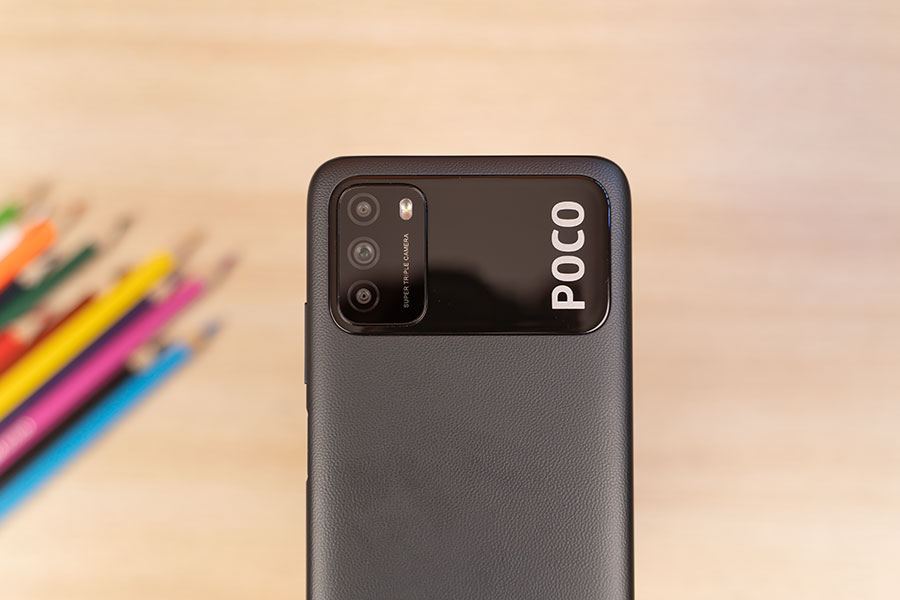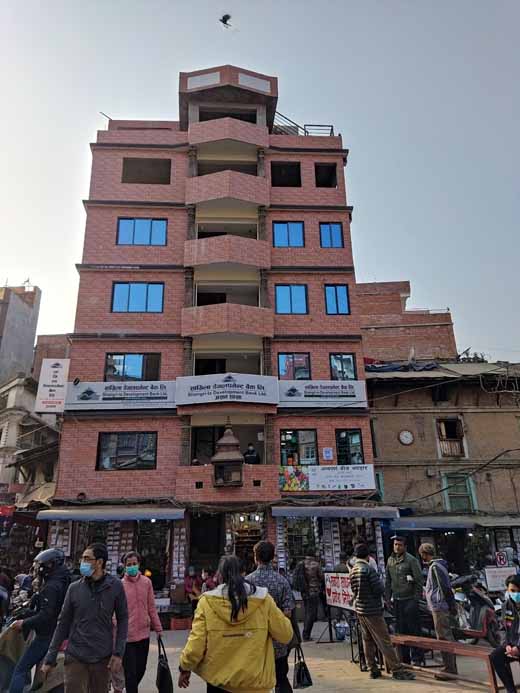
Xiaomi isn’t the best at coming up with product names. And the POCO M3 that I have with me is a prime example. Depending on the region, this phone has 4 different identities. It first debuted in China under the Redmi Note 9 4G branding which was repurposed as Redmi 9 Power for the Indian market. A couple of weeks later, Xiaomi decides to launch the same phone in Europe and few other Asian markets as Redmi 9T. Whew, that’s a lot! Anyway, leaving the naming scheme aside, how good is the POCO M3, and more importantly—was this a deserving successor to the M2? Let’s find out in this review of the POCO M3.
POCO M3 Specifications:
- Body: 6.39 x 3.04 x 0.38 inches, 198 gm
- Display: 6.53-inches “Dot Drop” IPS LCD, 395PPI, Corning Gorilla Glass 3, TÜV Rheinland Low Blue Light certification, NTSC 70%
- Resolution: FHD+ (2340 x 1080 pixels), 19.5:9 aspect ratio
- Chipset: Qualcomm Snapdragon 662 (11nm Mobile Platform)
- CPU: Octa-core (4×2.0 GHz Kryo 260 Gold & 4×1.8 GHz Kryo 260 Silver)
- Memory: 4/6GB RAM, 64GB UFS 2.1/128GB UFS 2.2 storage (expandable)
- Software & UI: MIUI 12 for POCO on top of Android 10
- Rear Camera: Triple-camera;
– 48MP, f/1.79 primary lens
– 2MP, f/2.4 depth sensor
– 2MP, f/2.4 macro sensor
– LED flash - Front Camera: 8MP, f/2.05 lens (notch)
- Audio: 3.5mm headphone jack, stereo speaker, Hi-Res audio
- Connectivity: Dual-SIM (Nano), WiFi 802.11 a/b/g/n/ac (Dual-band), Bluetooth 5.0, GPS / Glonass / Galileo / Beidou, USB Type-C, 4G LTE
- Sensors: Accelerometer, Ambient Light, Proximity, Vibration Motor, IR Blaster, Proximity
- Battery: 6000mAh with 18W charging (22.5W brick inside the box)
- Color options: POCO Yellow, Cool Blue, Power Black
- Price in Nepal: N/A (Not launched yet)
POCO M3 Review:
Design & Build
- Glass front, pseudo-leather back, plastic frame
- Comfortable to hold, decent tactile feedback
As usual, let’s start with the design. Here, the POCO M3 features bold aesthetics—specifically with its camera module. Additionally, the rear panel on both phones offers a different hands-on feel as well. POCO has opted for a pseudo-leather material here. Now, we all know it’s just textured plastic but it feels surprisingly nice on the hand.
Regardless, many of you might favor the POCO M3 between the two simply because of its striking resemblance with the Cyberpunk 2077 Edition of the OnePlus 8T as well. I’ll admit it’s a striking look but for me, it’s just too “in your face” to actually appreciate. Besides this, there’s not much to talk about on the design front. While the POCO M2 had a fingerprint scanner on the back panel itself, M3 substitute that for a sleeker side-mounted mechanism.
And yeah, although it’s a more ergonomic implementation, I have always been fond of the traditional fingerprint sensor placement. As expected, it’s a tad bit slower than the one on POCO M2. Thankfully, you can switch between how to actually trigger the sensor—simply by touching it or with the click of the button. If its speed doesn’t float your boat, you can go for face unlock too. Unlike its Redmi 9 Power sibling, water-repellent coating the POCO M3 misses out on a water-repellent coating.
Display
- 6.53-inches FHD+ IPS LCD screen
- Corning Gorilla Glass 3 protection
Moving forward with this review of POCO M3, let’s shift our gear to the display now. Unlike the design, it’s your standard budget phone stuff. You’re greeted with a 6.53-inches IPS screen with Corning’s Gorilla Glass 3 protection on top. Thankfully, it is a Full HD display contrary to how some manufacturers still ship with an inferior HD resolution on similarly priced phones. Anyway, even though POCO has tried its best to implicate a punch-hole cutout through its promotional materials (misleading a couple of my friends), it’s a regular notched screen.
![POCO M3 - Display [1]](https://cdn.gadgetbytenepal.com/wp-content/uploads/2021/02/POCO-M3-Display-1.jpg)
Talking about the quality of the display itself, it is pretty admirable for a budget phone. Content looks sharp and watching videos is a decent experience as well. Oh yeah, it is also Widevine L1 certified so that you can enjoy HD playback on your favorite streaming services. The colors, as usual, see a slight boost in contrast. After watching a couple of videos on YouTube, I noticed how they produced mildly greenish colors. However, this wasn’t much of an issue as I could easily play around with the color temperature inside the settings to achieve a desirable degree of color reproduction.
Moreover, there’s no visible discoloration around the edges either—so that’s great. Apart from this, the viewing angle and brightness levels are fairly decent as well. I don’t mean to say that you’ll have no problem looking at this screen under direct sunlight, but it performs a lot better than other budget phones I’ve tested in the past.
Performance
- Octa-core Qualcomm Snapdragon 662 SoC (11nm)
- 4/6GB LPDDR4X RAM with up to 128GB storage (expandable)
On the performance side of things, POCO M3 runs on Qualcomm’s 11nm Snapdragon 662 silicon. While it is more energy-efficient than the Helio G80 (12nm) in the M2, unfortunately, it is not as powerful. We saw Xiaomi do something similar with the Redmi Note 9 series too, which favored a more efficient chipset instead of a significantly more powerful one—coming from its predecessor.
![POCO M3 - Design [1]](https://cdn.gadgetbytenepal.com/wp-content/uploads/2021/02/POCO-M3-Design-1.jpg)
Here, the Snapdragon 662 has been paired with 4GB of LPDDR4X RAM and up to 128GB of internal storage. However, the Indian variant of POCO M3 gets 6GB of RAM—just like its predecessor.
UFS 2.1/2.2 storage
And depending on the storage variant, they feature different storage protocols. The 64GB option gets UFS 2.1 storage whereas the 128GB variant enjoys the newer UFS 2.2 protocol. Our review unit of the POCO M3 is of the 4/128GB configuration. Even though it’s painted out to be a remarkable upgrade over eMMC 5.1 on POCO M2, there’s not much of a difference between the two storage protocols and you’ll definitely not be able to clearly tell the difference between the two in real-life usage either.
Let’s take a look at some benchmark scores:
| Test | POCO M2 | POCO M3 | |
| Androbench | Sequential Read | 312.58MB/s | 508.68MB/s |
| Sequential Write | 255.92MB/s | 267.11MB/s | |
| AnTuTu v8 | Total | 204202 | 186230 |
| CPU | 73222 | 71281 | |
| GPU | 43089 | 34471 | |
| Memory | 44402 | 47232 | |
| UX | 43489 | 33246 | |
| Geekbench 5 | CPU (Single Core) | 344 | 315 |
| CPU (Multi-Core) | 1348 | 1348 | |
| Compute (OpenCL) | 1152 | 378 | |
| PCMark (Work 2.0 Performance) | 8846 | 6008 | |
| 3DMark (Wild Life) | N/A | 376 | |
As you could see, the Snapdragon 662 on the POCO M3 clearly lag behind the Helio G80 on the POCO M2. While you won’t notice the difference upon light usage, bring multitasking, gaming into the mix—and you’re heading towards a significant disappointment. First off, MIUI isn’t particularly known for its lightweight nature so even 4GB RAM feels insufficient. Talking about MIUI, you also get ads on these phones like usual. Nothing lewd or NSFW ads like with Xiaomi phones in the past, but still.
In terms of bloatware, POCO M3 comes pre-installed with a bunch of frivolous games that you can thankfully uninstall. In any case, let’s get into the gaming performance now. Non-demanding titles aren’t a hassle but heavyweight games like PUBG Mobile and COD Mobile do take a toll on this phone.
Gaming experience
PUBG Mobile is maxed out at Smooth graphics/High frame rate or Balanced graphics/Medium frame rate. To recall, its predecessor hit Balanced graphics/Ultra frame rate or HD graphics/High frame rate. The gameplay is fairly smooth on either setting but you’re gonna notice slight stutters every now and then.
![POCO M3 - Display [2]](https://cdn.gadgetbytenepal.com/wp-content/uploads/2021/02/POCO-M3-Display-2.jpg)
On the other hand, COD Mobile can be cranked to Very High graphics/High frame rate—although I would highly suggest you dial down the graphics settings down to Medium for balanced gameplay. Surprisingly, the POCO M2 could only reach Medium graphics and High frame rate.
Remember how I talked about this phone being energy efficient, that becomes evident when you’re gaming for at least an hour or so as it doesn’t get warm nearly as fast enough as the POCO M2. To further optimize your gameplay, you can also play around with the Game Turbo profile—which gives you access to various features like taking a screenshot, floating apps, voice changer, etc. on top of optimizing the phone’s resources.
Cameras
- Triple camera setup at the back
- (48MP primary, 2MP depth, 2MP macro)
- 8MP selfie camera inside the teardrop notch
With that out of the way, let’s talk cameras. POCO M3 sports a triple camera setup, lacking an ultrawide sensor compared to M2. Besides this, you get a 48MP primary lens and two 2MP sensors for depth, macro images.
Normal, Wideangle Images
With the upgraded 48MP sensor, POCO M3 brings some noticeable upgrade in image quality.
First off, the oversaturated colors of the POCO M2 have been replaced with more natural-looking saturation on its successor. As a result, I prefer the primary images on the POCO M3 more.
Not to forget, it significantly wins out in terms of details as well. It’s the same with wideangle images too.
Portrait Images
On the other hand, portrait images differ in terms of color science too.
While photos from the POCO M2 look reddish and a tad-bit unnatural—the M3 produces noticeably better-looking shots. But it’s still far from perfect as it substitutes the red-tint on the M2 with a yellowish hue instead.
Macro Images
It does macro shots better too—producing close-to-natural colors while the POCO M2 oversaturates the subject to oblivion.
Still and all, getting an acceptable macro shot is drab with the fixed focus lens.
Selfie Images
Here, the selfie and portrait selfies look better with greater detail and more natural color tone on the POCO M3 as well.
Still, it has this yellowish hue while the selfies from POCO M2 look reddish and unnaturally overblown in terms of details.
Nighttime Images
And while its predecessor didn’t have a dedicated night mode, POCO has included one on the M3.
As a result, low-light images are way better here although HDR works surprisingly well on the POCO M2.
Videography
In terms of videos, both phones max out on 1080p/30fps recordings from both primary and front-facing camera. Neither does a great job and there’s not much of a difference in the quality of footage between them.
Battery & Audio
- 6000mAh battery with 18W fast charging
- Stereo speaker setup, Hi-Res audio certified
Finally, let’s get into the battery. And without a doubt, it’s one of the best property of this phone. Powered by a big 6000mAh cell, the POCO M3 will easily last you through the day—even under a high workload. I consistently managed to get around 7 – 8 hours of screen on time. Moreover, even though you’re getting a big battery, it isn’t as unwieldy or uncomfortable as the POCO X3.
![POCO M3 - Design [2]](https://cdn.gadgetbytenepal.com/wp-content/uploads/2021/02/POCO-M3-Design-2.jpg)
In terms of charging, you get a 22.5W power adapter inside the box although the phones only support 18W of maximum power. With this, it takes around 2 hours 48 minutes to completely juice up the phone from 0 to 100%. Even though the phone has a stereo speaker setup with Hi-Res audio, its audio quality is pretty average. It does get loud but there’s not much to enjoy in terms of details.
Conclusion
Wrapping up this review of the POCO M3, while it’s a competent phone in itself, it doesn’t feel like a valuable addition to the company’s portfolio. It does bring a decent upgrade in terms of the cameras compared to the M2, but that’s about it when talking about the noteworthy improvement. Instead of rehashing the same phone for a quick buck, I strongly believe POCO could’ve done so much better by working on a true successor product instead.
POCO M3 Review: Pros & Cons
Pros:
- Bold, yet ergonomic design
- Decent display quality
- Energy-efficient performance
- Upgraded camera quality
- Excellent battery life
Cons:
- Not much of a performance upgrade
- Its bold design may be off-putting





























































![Best Gaming Laptops in Nepal Under Rs. 250,000 (रु 2.5 Lakhs) [2025] Best Gaming Laptops Under 2.5 lakhs in Nepal [Feb 2025 Update]](https://cdn.gadgetbytenepal.com/wp-content/uploads/2025/02/Best-Gaming-Laptops-Under-2.5-lakhs-in-Nepal-Feb-2025-Update.jpg)
![Best Gaming Laptops in Nepal Under Rs. 120,000 (रु 1.2 Lakhs) [2025] Best Budget Gaming Laptops Under Rs 120000 in Nepal 2025 Update](https://cdn.gadgetbytenepal.com/wp-content/uploads/2025/05/Best-Budget-Gaming-Laptops-Under-Rs-120000-in-Nepal-2024-Update.jpg)
![Best Laptops Under Rs. 80,000 in Nepal [2025] Best Laptops Under 80,000 in Nepal March 2025 Update](https://cdn.gadgetbytenepal.com/wp-content/uploads/2025/03/Best-Laptops-Under-80000-in-Nepal-March-2025-Update.jpg)
![Best Gaming Laptops in Nepal Under Rs. 200,000 (रु 2 Lakhs) [2025] Best gaming lapotp under 2 lakhs Nepal Feb 2025](https://cdn.gadgetbytenepal.com/wp-content/uploads/2025/01/Best-Gaming-Laptops-Under-2-Lakh-Nepal-Feb-2025-Update.jpg)

![Best Mobile Phones Under Rs. 15,000 in Nepal [Updated 2025] Best Phones Under 15000 in Nepal 2024 Budget Smartphones Cheap Affordable](https://cdn.gadgetbytenepal.com/wp-content/uploads/2024/03/Best-Phones-Under-15000-in-Nepal-2024.jpg)
![Best Mobile Phones Under Rs. 20,000 in Nepal [Updated] Best Mobile Phones Under NPR 20000 in Nepal 2023 Updated Samsung Xiaomi Redmi POCO Realme Narzo Benco](https://cdn.gadgetbytenepal.com/wp-content/uploads/2024/01/Best-Phones-Under-20000-in-Nepal-2024.jpg)
![Best Mobile Phones Under Rs. 30,000 in Nepal [Updated 2025] Best Phones Under 30000 in Nepal](https://cdn.gadgetbytenepal.com/wp-content/uploads/2025/01/Best-Phones-Under-30000-in-Nepal.jpg)
![Best Mobile Phones Under Rs. 40,000 in Nepal [Updated 2025] Best Phones Under 40000 in Nepal 2024 Smartphones Mobile Midrange](https://cdn.gadgetbytenepal.com/wp-content/uploads/2024/02/Best-Phones-Under-40000-in-Nepal-2024.jpg)
![Best Mobile Phones Under Rs. 50,000 in Nepal [Updated 2025] Best Phones Under 50000 in Nepal](https://cdn.gadgetbytenepal.com/wp-content/uploads/2025/01/Best-Phones-Under-50000-in-Nepal.jpg)
![Best Flagship Smartphones To Buy In Nepal [Updated] Best flagship phone 2025](https://cdn.gadgetbytenepal.com/wp-content/uploads/2024/07/Best-Flagship-Phones-who-is-it-ft-1.jpg)